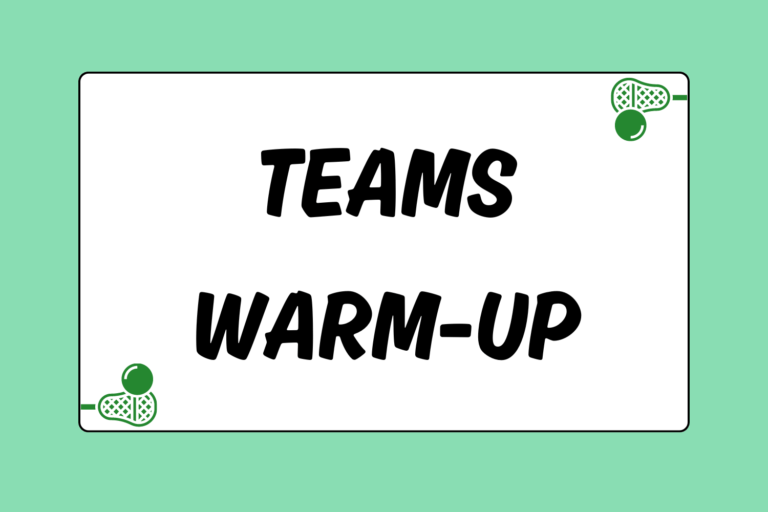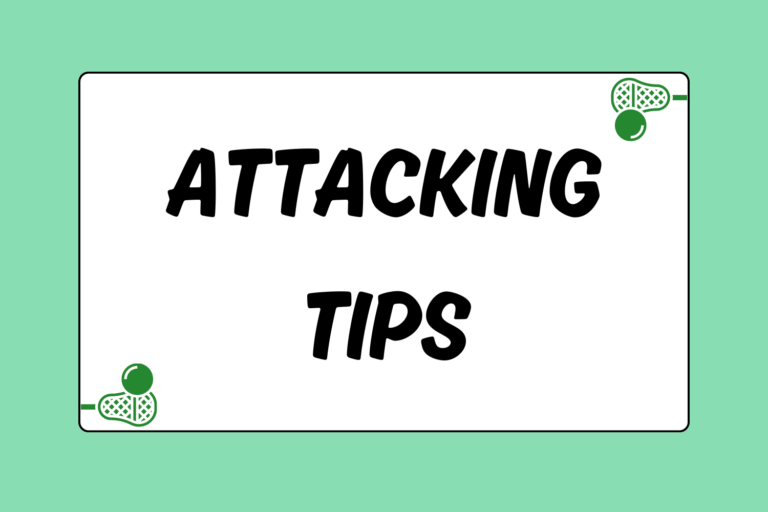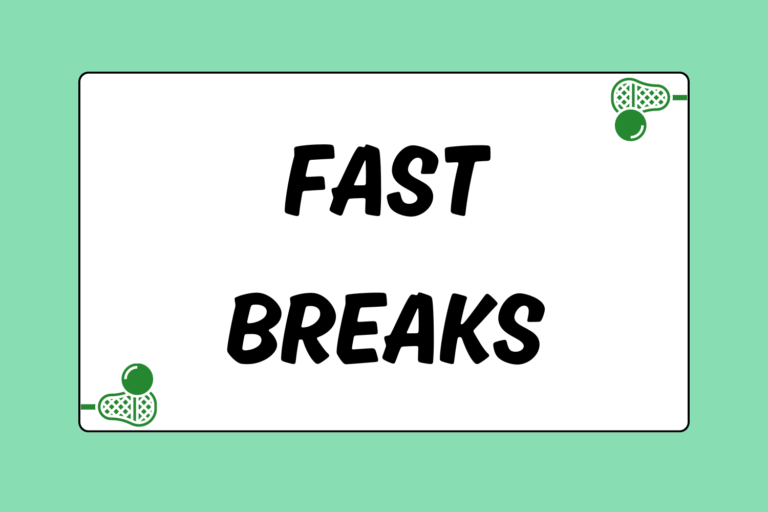A
Assist – The last offensive pass that sets up a goal. An assist is awarded if the receiver of the pass does not have to dodge a defender on his way to the goal. One assist per goal may be awarded.
Attackman – One of three players designated to remain on the offensive side of the field at all times. Attackmen generally possess the best stick-handling skills on the field and play close to the goal or behind the goal.
B
Back door – As the ball is on the perimeter, an offensive player on the back side of the play cuts behind their defender to the far post to receive a pass near the goal for a quick shot.
Baggataway – Ojibwe word for lacrosse (derived from an Algonquian verb meaning “to hit with something”), and more particularly, the Midwestern/Great Lakes variant of the game.
Bagged – Refers to when the pocket of a player’s stick has been severely deepened, and resembles a bag.
Behind-the-back – The most commonly used trick shot or pass, it involves a player throwing the ball behind his head rather than forward; also commonly referred to as a BTB.
Body check – When one player hits another player with his body. This is legal, as long as the player being hit has the ball or is within five yards of a ground ball.
C
Catching – The action of receiving a pass or shot in one’s stick.
Checking – Striking another player with the stick in an attempt to dislodge the ball.
Check-up – Call made by a goalie or coach indicating that their defensive players should announce who they are guarding at that moment.
Clamp – A face-off move where the player pushes his stick down on top of the ball to gain control.
Clear – Moving the ball from the defensive end to the offensive end of the field.
Cradling – Rocking the stick back and forth in the hands to create centrifugal force that keeps the ball in the pocket.
Crank – A slang term used to describe a hard shot taken by a stationary player who has time and room to wind up and fire it.
Crease – The circle surrounding the goal. In the men’s game, its radius is 9 feet. In the women’s game it’s 8.5 feet. In the National Lacrosse League, the radius of the crease is 9 feet, 3 inches.
Cross check – When one player hits another with his stick, striking the player with the part of the shaft between his hands. In field lacrosse, this draws a one-minute penalty. In the NLL, it’s legal.
Crosse – Traditional term referring to the stick used by lacrosse players.
Cutting – The action of moving without the ball to place oneself in a good scoring position or to open up space for another offensive player.
D
Defenseman – One of three players designated to remain on the defensive side of the field at all times. Generally, defensemen use sticks that are six-feet long to aid with checking attackmen.
Dime – Slang term used to describe a nice or difficult pass. Ex: “He threw me a dime right in front of the net and I scored an easy goal.”
Dish – Another slang term referring to the passing of the ball from one player to another, generally a short pass in a tight space.
Dodge – Any evasive move by an offensive player who is trying to get past a defensive player.
Double-team – Defensive strategy in which two defensive players guard one offensive player in an attempt to strip the ball or force the offensive player to lose possession.
D-Pole – Slang term for defenseman.
E
Extra man offense (E.M.O.) – Refers to the unit of six offensive players who play while their team has a man advantage due to a penalty by the opposing team.
F
Fast break – When a midfielder or defenseman breaks ahead of the rest of the middies and brings the ball downfield to the attack. The result is a 4-on-3 advantage for the offense that usually creates a scoring chance.
Feed – Basically a pass, but more specifically a pass inside to an offensive player who is right in front of the goal or around the crease.
Five and five – The area five yards wide of and five yards upfield from the goal where an attackman attempts to reach in order to shoot or feed.
FOGO – A term for a player who takes face-offs but then runs off the field as soon as possible afterwards. It stands for Face-Off, Get Off.
Foul Out – The term used to describe the ejection of a player when he receives his fifth foul in one game. This doesn’t happen often.
G
Garbage goal – A goal scored in an unsettled situation like off a rebound or fast break, or one scored immediately following a defensive gaffe.
Gilman – Refers to a defensive player throwing the ball as far as possible to the offensive end of the field rather than passing the ball to a teammate. Also the name of a private school in Baltimore, Maryland that regularly produces one of the best boys high school teams in the United States.
Goal – Refers to the structure which players attempt to throw the ball into for a point. It’s also the term that refers to what happens when a player scores. In field lacrosse for both men and women, the goal is a six feet by six feet square. In the National Lacrosse League, it’s four feet tall and four feet, nine inches wide.
Goalie/Goaltender – The last line of defense, the goalie has a larger stick head (roughly 16.5 inches across) to help stop shots from the opposing team as he stands in front of his team’s goal.
Goose – When a player uses his stick to knock a ground ball to an open teammate, rather than picking it up.
Ground ball – Simply put, it is a ball that is on the ground, rather than in the possession of a player on the field.
H
Hanging the stick – This is when a ball carrier holds the stick in such a way as to enable a defender to easily get a check on his stick and dislodge the ball.
Head – The plastic part of the stick that holds the ball.
Holding – Occurs when a player impedes the movement of an opponent or an opponent’s stick.
Hole – The area right in front of the goal. Because an open offensive player in front of the goal is more dangerous than an open offensive player somewhere else, defensive players are told to “get in the hole,” meaning they should run to the goal then find the player they need to cover.
I
Illegal body check – A body check that is delivered in any of the following fashions: Above the neck, below the waist, from behind, or to a player who is not in possession of the ball.
Illegal gloves – Gloves that do not have palms are considered illegal.
Illegal Screen – A screen is considered illegal when a player sets one without having his feet set (Also see “Screen”).
Illegal stick – An illegal stick results in a penalty for the offending player. Sticks are illegal if they are too short, too long, too wide, too narrow, or have too deep of a pocket, or no end cap. Broken sticks are also considered illegal for the field of play.
Interference – Occurs when a player interferes in any manner with the free movement of an opponent, except when that opponent has possession of the ball, the ball is in flight and within five yards of the player, or both players are within five yards of a loose ball.
Invert – An offensive formation or play in which a midfielder will carry the ball to a position normally occupied by an attackman (for example, X), or vice-versa, and then initiate the offense.
L
Laser – Slang term for a very hard shot.
LSM – Long Stick Midfielder: A midfielder who plays with a long stick and is defense oriented. Usually guards the opposing team’s best midfielder.
M
Man-down defense – Refers to the unit of five or fewer defensive players assigned to prevent the other team from scoring while the defending team is short-handed as a result of any penalties committed.
Man-to-man defense – Team defensive strategy in which each defensive player is assigned to exclusively guard or cover one offensive player.
Mark-up – Call used by the goalie or other defensive players when asking teammates to call out who they are guarding in the man-to-man defense.
Mesh – Piece of woven nylon used as a pocket in lacrosse sticks. The majority of male players use mesh in today’s game.
Midfield line – Line that runs directly across the middle of the field from sideline to sideline. It is used to determine if a play is offsides.
Midfielder – One of three players who plays at both ends of the field, both offensively and defensively.
MLL – Major League Lacrosse. This professional outdoor league based in the United States was founded in 2001.
Motion – Offensive style or system in which players move and cut simultaneously to create space and feeding/shooting opportunities for other players on the field.
N
NCAA – National Collegiate Athletics Association. The governing body for all colleges and universities competing at the varsity level.
NLL – National Lacrosse League. A professional indoor league with teams in the United States and Canada; founded in 1987.
O
Offsides – Rule stating that each team must have four players on the defensive half of the field, as well as three players on the offensive half of the field, at all times. An offsides penalty results in a 30-second technical foul on the offending player and his team.
On-the-fly – A manner of substituting in which a team replaces a player on the field while the ball is in-bounds and the clock is running.
On-the-hop – Call made by a coach indicating to his players to quicken their pace during practice and drills.
P
Pass – When one player uses his stick to throw the ball to another player.
Pick – Offensive technique used by an off-ball player to free up a teammate with the ball. This is done by standing in the path of the on-ball defender, allowing the offensive player with the ball to free himself up to dodge, shoot, or pass.
Play-on – A penalty or infraction that is noticed by the referee, but, if called immediately, would stop the advancement of the team that was fouled. A flag is thrown and the referee shouts “Play on” and continuation is allowed. At the next loose ball, turnover, or score, the whistle is blown and the penalty is assessed. If a goal were scored, it would count and the face-off would ensue with the penalty in force.
Pocket – The net part of the stick attached to the head that holds the ball.
Popcorn – Slang term for a very easy shot to save.
Q
Quick stick – This is the action by which a player catches a pass and then redirects the ball without cradling for a shot or pass.
R
Rack – Slang term for the goal.
Rake – A way to pick up the ball by placing the head of the stick over the ball, and then “raking” the stick backwards onto the ground while applying downward force so that the ball rolls into the pocket.
Release – Call made by an official at the conclusion of a penalty to indicate that an offending player is to be released from the box; also a call made by a player who has just picked up a ground ball indicating to teammates that their team has gained possession.
Ride – One team trying to stop another from clearing the ball out of its defensive zone.
Rip – Term used to describe a very hard shot. Ex: “He ripped it so hard that it almost went through the net!”
Rock – Slang term for the ball.
S
Save – When a goalie stops a shot that otherwise would have gone into the goal.
Scooping – The act of using one’s stick to “scoop” under a ground ball to pick it up.
Screen – When a player impedes the vision or running path of an opposing player by standing directly in front of that player; sometimes used to prevent a goalie from getting a good look at an oncoming shot.
Shaft – The metal or wooden handle of the stick.
Shoot – When a player throws the ball towards the opponent’s goal, attempting to score a point for his team.
Sidewall – Can refer to either the two vertical sides of the stick head, or the string that attaches the pocket to the sides of the stick.
Slashing – Penalty committed by striking an opponent anywhere on the body besides the stick or hand holding the stick.
Slide – This occurs when an offensive player gets past his defender, forcing another defensive player to “slide” over and pick up the threatening offensive player.
Slow break – A transition opportunity for the offense in which the defense has at least an equal number of defenders to offensive players in position and ready to defend.
Stalling – A tactic where the team with possession (and usually in the lead) runs around and passes from teammate to teammate in order to kill time, rather than try to score.
Stick – The most basic piece of equipment needed to play lacrosse, it is comprised of a shaft (metal or wood) and head (plastic).
Stick doctor – Title given to a player on a team renowned for his ability to string a stick.
T
Time and Room Shot – When a player has time to set his feet and room around him to take a very hard shot.
Top shelf – Slang term that refers to the upper area of the goal underneath the top crossbar.
Traditional – Uncommon stringing technique for men’s sticks, using four leather strands connected by laces to form a pocket.
Transition – When the ball moves quickly from one end of the field to the other, often resulting in a fast break.
Tripping – Penalty committed by using any part of a player’s body or stick to make an opponent lose his balance and fall to the ground.
U
U.S. Lacrosse – The governing body of the United States men’s and women’s games. Also the publisher of Lacrosse Magazine.
Unnecessary roughness – Occurs when a player strikes an opponent with his stick or body with excessive or violent force.
Unsettled situation – Any situation in which the defense is not positioned correctly, usually due to a loose ball or broken clear.
Unsportsmanlike conduct – Occurs when any player or coach commits an act which is considered unsportsmanlike by an official. These acts include taunting, arguing, or obscene language or gestures.
V
V-Cut – Running in one direction, and then breaking back in the opposite direction to receive a pass. The runner’s path will resemble the letter “V.”
W
Warding off – Infraction committed by an offensive player who cradles one handed while using the other hand or arm to move, block or interfere with a defender’s stick.
Wheels – A call made by a coach or teammate to a player indicating that the player should run as fast as possible. Also used to refer to a player with great speed (Ex: “That guy has wheels.”)
Whip – Term used to describe the feeling of the ball catching on the shooting strings as it releases from the pocket of the player’s stick. Also referred to as “hook.”
Wing area – Area adjacent to and on either side of the goal.
X
X – Area of the field directly behind the goal. Also refers to a position played normally by a team’s best passing attackman.
Y
Yard sale – Term referring to a player’s stick that has been checked out of his hands and lies on the ground, resembling an item at a yard sale.
Z
Zone defense – Style of defense in which each player is responsible for one area or “zone” of the field, rather than an individual offensive player.





